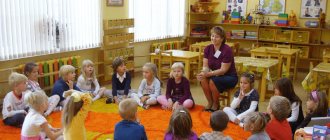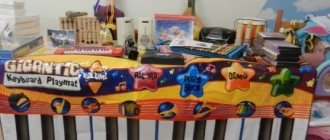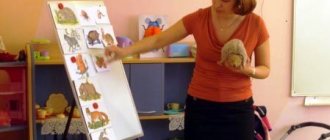Card index of conversations on moral education card index (senior group) on the topic
Card file of conversations on moral education
Topic #1: Why do they say “hello”?
Goal: To form in children the basic rules of etiquette when meeting. Introduce greeting methods. To consolidate ideas about the importance and necessity of using “kind words” in colloquial speech, to arouse the desire to use them.
Topic No. 2: “My good deeds”
Goal: to deepen children’s understanding of kindness as a valuable, integral quality of a person. Improve communication skills (the ability to listen to a friend, sincerely express one’s opinion, show kindness to the opinions of other children), skills of cultural communication with peers. Achieve friendly intonation expressiveness of speech. To cultivate in children friendly relationships, feelings of self-esteem and respect for others, the ability and desire to come to the aid of adults and peers.
Topic #3: “What is kindness?”
Goal: To form children’s idea of kindness as an important human quality. Encourage the desire to do good deeds; strengthen children’s ideas about good deeds, understand that polite words help people communicate. Form moral ideas about kindness. Cultivate kind feelings towards people around you.
Topic No. 4: “Hurry to do good”
Goal: Continue familiarization with the polar concepts of “good” and “evil.” Form a conscious attitude towards social norms of behavior, consolidate the skills of friendly behavior in everyday life. Introduce ways to resolve conflict associated with feelings of anger, as well as ways to manage and regulate mood. Continue to cultivate friendly relationships between children.
Topic No. 5: “If you are kind...”
Goal: To develop in children the need for friendly communication with others, to consciously show empathy and perform kind deeds. To teach to understand the meaning of proverbs about goodness, the ability to associate the meaning of a proverb with a specific situation. Teach children to show kindness and responsiveness to everyone who needs it.
Topic No. 6: “Polite words”
Goal: To teach children the rules of etiquette, forms and techniques of communication when meeting with acquaintances and strangers, the rules of using greetings. Help overcome shyness and stiffness in children. Develop the ability to express your opinion in a cultural way, listen carefully to your interlocutors. Teach formulas for expressing polite requests and gratitude.
Topic No. 7: “Accidentally and on purpose”
Goal: to develop moral feelings - regret, sympathy; develop gaming communication skills without hurting your partner’s interests.
Topic No. 8: “Learning to forgive our friends”
Goal: to develop children’s ability not to be offended by each other; develop the ability to distinguish between an accidental mistake and an intentional one and react accordingly; lead children to understand the words “peace-loving”, “touchy”.
Topic No. 9: “Why do there be fights?”
Goal: to develop communication skills in children; develop an understanding of the meaning of norms and rules of behavior among peers; cultivate the habit of behaving with dignity in every situation.
Topic No. 10: “Dreamers and liars”
Goal: to develop the ability to distinguish between deception and fiction, fantasy; develop a desire for truthfulness and tact.
Topic No. 11: “Let’s make peace”
Goal: develop the ability to restrain negative impulses, avoid conflicts, find words to evaluate behavior. Teach children to be responsive and sensitive.
Topic No. 12: “A good friend is a friend in need”
Goal: to form the idea that a true friend knows how to empathize and help in difficult times; develop the ability to be merciful to each other.
Topic No. 13: “How to behave during a conversation”
Goal: to introduce children to the rules of behavior during a conversation.
(Speak in a polite tone. Use “magic” words. Look at the interlocutor’s face. Do not keep your hands in your pockets. You should not eat during a conversation. If two adults are talking, the child should not interfere in their conversation, much less demand that it stop) .
Topic No. 14: “Good - Evil”
Goal: To teach to give a moral assessment to the actions of heroes, to cultivate a desire to be kind and humane. To help you understand that a kind person can be called a person who always helps others and does not remain indifferent in situations that are difficult for other people.
Teach to distinguish good deeds, create a desire to do good deeds towards people around you.
Topic No. 15: “Truthfulness”
Goal: To form ideas about the moral concept of “truthfulness”, to teach how to give a moral assessment of the hero’s actions, to help understand that a lie does not decorate a person.
Topic No. 16: “What a friend should be”
Goal: To form ideas about positive character traits and moral actions, to deepen ideas about friendship. Cultivate respect, patience and friendliness towards your comrades, teach them to correct their mistakes, and ask for forgiveness in conflict situations. Teach children to be responsive and sensitive.
Topic No. 17: “Be neat and tidy”
Goal: To teach children to take care of their appearance. Help you understand that a well-mannered person always looks neat.
Topic No. 18: “Truth is not true”
Goal: To explain to children that they should not deceive others, that they should always tell the truth, that truthfulness and honesty always please adults, that these qualities are highly valued in a person, that they are praised for telling the truth. Help children understand that any lie is always revealed, and the person who lies feels guilty not only for his own offense, but also for the fact that he told a lie.
Topic No. 19: “Goodwill”
Goal: to continue to instill in children a negative attitude towards rudeness. Explain to children that the one who teases not only offends others, but also causes harm to himself (no one wants to be friends with such a person).
Topic No. 20: “Games without quarrels”
Goal: Explain to children that a quarrel interferes with play and friendship. Learn how to resolve controversial issues, avoid quarrels, don’t get angry when you lose, don’t tease the loser...
Topic No. 21: “Politeness”
Goal: To teach children to use polite words, develop appropriate skills of cultural behavior, observe the rules of etiquette, using the example of images of literary heroes, stimulate positive forms of behavior and inhibit negative ones. That you need to communicate with others calmly, without shouting, that you should express your requests in a polite tone.
Topic No. 22: “Thrift”
Goal: To teach children to treat things with care and precision, otherwise they will quickly lose their appearance and become unusable. Teach to appreciate the work of those who made this thing, who bought it, earning money.
Topic No. 23: “Mutual assistance”
Goal: Explain to children that all people sometimes need support, but not everyone can ask for help; It is very important to notice the person who needs help and help him. That you need to help not only acquaintances, but also strangers.
Topic No. 24: “The desire to help”
Goal: To develop emotional responsiveness, the desire to help, showing empathy. Teach children to be responsive and sensitive.
Topic No. 25: “Generosity and Greed”
Goal: To reveal the meaning of the concepts of “greed” and “generosity”. Develop the ability to evaluate your attitude towards positive and negative actions. Understand that being greedy is bad, but generous is good.
Topic No. 26: “Why you need to be able to give in”
Goal: to teach children to avoid quarrels, give in and negotiate with each other. Develop the ability to evaluate your attitude towards positive and negative actions.
Topic No. 27: “Steps of kindness”
Goal: based on the content of Russian folk tales, to form in children an idea of justice, courage, modesty and kindness, to cultivate a negative attitude towards negative qualities: lies, cunning, cowardice, cruelty. Learn to convey your attitude to the content of the fairy tale and the actions of the characters.
Topic No. 28: “It’s better to be kind”
Purpose: To give children an idea of an indifferent, indifferent person and his actions. Teach children to distinguish between the external manifestations of an emotional state (anger, indifference, joy). Learn to analyze actions, find the cause of the conflict, ways to resolve conflict situations and promote their assimilation in behavior. Generalize the idea of kindness and evoke the desire to do good deeds.
Topic No. 29: “How to dress in cool weather?”
Goal: To generalize and consolidate the skills of correct, consistent dressing and changing clothes. Develop attention and observation. Foster independence, the ability to determine what to wear according to the weather.
Topic No. 30: “We are traveling in transport”
Goal: To familiarize children with the rules of behavior in transport: give way, be polite, do not push, etc. Develop attentiveness and observation. Cultivate a friendly attitude towards people traveling in transport.
Thematic planning for spiritual and moral education
Middle group
September.
Subject: “Hello, it’s me!”
Goal: to form in children basic rules of behavior, ethics of communication and greetings; cultivate respect for surrounding adults and peers.
Objectives: to encourage children to be friendly when communicating in kindergarten and at home, to use “polite words” in their speech, to reveal to children the essence of the concept of “politeness”; develop communication skills in relation to peers and adults; cultivate a desire to give joy and good mood to loved ones.
- Did. game “What is your name and where do you live?”
- Game situation “Learning to speak correctly.”
- Lesson: “Always be polite.”
- Game sketch “Say a good word to your neighbor.”
- Conversation “What does it mean to be polite?”
October.
Topic: “Our friendly family.”
Goal: to form children’s idea of family and family clan, of friendly relations between relatives.
Tasks:
- Reading literary works.
- Conversation “What is family.”
- Getting to know proverbs and sayings about family and home.
- Lesson “Who are we in our family?”
- Did. game “How can we be called differently?”
- Role-playing games “Mothers and Daughters”, “Family”.
- Artistic and creative activity: drawing “Mom, Dad and I are a friendly family.”
November.
Topic: "Friendship".
Goal: to form ideas about friendship, friend.
Objectives: develop communication skills with peers: do not offend, forgive friends, sympathize with them; learn to find friends; analyze the situation and find a way out of it that is acceptable to everyone.
- Conversations: “Quarrel”, “How to make peace?”
- Reading literary works.
- Lesson "We will not quarrel."
- Conversation “Friendship begins with a smile.”
- Game situations: “Don’t forget about a friend”, “Help a friend”, “How to cheer a friend up”.
- Hood. — creative activity: application “Postcard for a friend.”
- Did. game "Find Friends".
December.
Topic: “Bring joy to people through good deeds.”
Goal: to develop a caring attitude towards other people.
Objectives: to consolidate the concept of “kindness, kindness, mercifulness”, develop empathy (feeling into the inner world of another person), feel responsiveness, attention, form a culture of communication; the desire to do good deeds and deeds.
- Reading literary works.
- Game situation: “I will carry out the assignment”, “What would I praise myself for today?”, “What would you do?”
- Lesson "Our good deeds."
- Did. game "Good-bad".
- Hood. — creative activity: modeling “Let's help forest animals.”
January.
Topic: "Fairy-tale characters."
Goal: to help children understand the concepts of “good” and “evil”, teach them to distinguish between them.
Objectives: teach children to analyze actions using the example of fairy-tale characters; reinforce the concepts of kindness and evil with specific examples; learn to identify emotions using conventional graphic images; instill in children a desire to be kind and help others.
- Reading literary works.
- Game situations: “Little Red Riding Hood”, “Gifts from Santa Claus”.
- Lesson “Journey to Dunno”.
- Hood. — creative activity: drawing “My favorite fairy-tale hero.”
- Conversations: “Why don’t I like Baba Yaga?”
- Tabletop theater. (showing children familiar fairy tales).
February.
Topic: “Dad, grandfather - soldiers.”
Goal: to give children’s understanding of public holidays and the work of the military.
Objectives: to introduce children to the national holiday “Defender of the Fatherland Day”; formulate the concepts of “military, air, land and sea transport”; differentiate professions by wax type; introduce children to Russian festive culture. To cultivate a good attitude towards your grandfather and father, to evoke a feeling of pride and joy that grandfather and father served in the army and defended our Fatherland and us.
- Reading literary works.
- Conversations: “I want to be like my dad,” “Who protects our Motherland?”
- Lesson “I would like to become a pilot.”
- Entertainment "Defender of the Fatherland Day".
- Did. game “What does a border guard need?”
- Did. game “How did our grandfathers defend this world?”
- Hood. — creative activity: drawing “Planes are flying through the clouds”; applique "Holiday card for dad."
- C/role-playing games “Border Guards”.
- Game exercise “Who is my dad’s grandfather?”
March.
Topic: “My mother is the best.”
Goal: to deepen children's sense of affection and love for the closest person - their mother.
Objectives: continue to form in children an idea of the family, the ability to name family members; differentiate the concept: my mother's mother. Encourage children to show care and love for their loved ones. Cultivate a sense of gratitude for her care for the people around her.
- Reading literary works.
- Conversations: “I want to be like my mother,” “What can I do to please my mother?”
- Role-playing games: “Mothers and Daughters”, “Family”.
- Lesson “My mother is the best.”
- Game situations: “I’ll help mom prepare dinner,” “Choosing gifts for mom.”
- Hood. — creative activity: application “Flowers for Mom”; drawing "Portrait of my mother."
- D. games: “What is my mother like?”
- Entertainment "Mom's holiday".
April.
Topic: “Emotional state of children and adults.
Goal: to contribute to the improvement of the intellectual and emotional spheres of preschool children, to develop moral motives of behavior.
Objectives: develop thinking and emotional-volitional processes; help children feel and learn to understand emotions; analyze the actions of the heroes, find creative solutions; to form moral ideas using the game.
- Lesson "Antics, boasters and teasers."
- Reading literary works.
- Conversations: “How your friend feels,” “Mood,” “How I see myself.”
- Game situations: “I give you a smile”, “Joyful meeting”, “Who is happy, sad, angry.”
- Examination of photographs, drawings with various images of a person’s emotional state.
- Did.games. “Good-bad”, “Happy-sad”.
May.
Topic: “I don’t offend anyone and help everyone.”
Goal: to develop respect for others, the ability to take into account their desires and requests.
Objectives: to form the habit of responding to requests from family, friends and acquaintances; teach to protect the weak, express sympathy, express the desire to help them, please them, not upset them.
- Reading literary works.
- Conversations: “Why we need to help and protect children,” “Might is not right,” “How we take care of our loved ones.”
- Game situations: “Who will help the girls?”, “What would you do?”, “Letters from a good storyteller.”
- Conversation “When I grow up.”
- Lesson “If you are kind.”





